
Invented in Russia: Our Contributions to Scientific and Technological Progress
/ Главная / Russkiy Mir Foundation / Publications / Invented in Russia: Our Contributions to Scientific and Technological ProgressInvented in Russia: Our Contributions to Scientific and Technological Progress
Svetlana Smetanina
The icebreaker, backpack parachute, tramcar, and foam fire extinguisher—all of these things have long belonged to the list of human achievements. Most people don’t know that they owe their existence to Russian inventors. At the turn of the twentieth century, Russia had one of the strongest schools of inventors in the world, although in many ways it developed in spite of circumstances. We discussed this topic with Tim Skorenko, the author of the book Invented in Russia and editor-in-chief of the Popular Mechanics website.
– Where did you get the idea to write this book and how did you prepare for it? In preparing this book, you used something like four thousand documents…
– Of course, I didn’t read four thousand books in order to write one—I just made use of a large quantity of sources. How did the book come about? You can find a huge number of various materials and lists titled “Conceived in Russia.” And in 99% of cases very strange things are written there. Recently I came across the assertion that the electric car was invented in Russia. Of course not. Meanwhile, a great number of actual Russian inventions aren’t mentioned because it’s difficult to talk about them. It’s simpler to say we invented the bicycle (untrue) than to dig a little deeper and write that we invented, say, the turbodrill. But then you need to go and explain what a turbodrill is, while a bicycle doesn’t need any explanation. In general, these lists always irritated me. But I don’t like to waste my time arguing on the Internet, so I went and wrote this book.
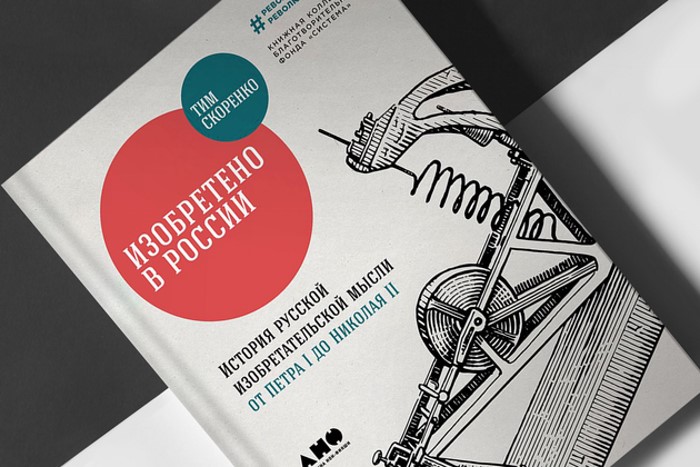
Tim Skorenko’s book Invented in Russia. [Photo: maxpark.com]
– Your book is subtitled “The history of Russian inventive thought from Peter I to Nikolai II.” Why did you choose this particular historical period?
– This is the first part. There will also be a second. It was just logically convenient to break up the period when a Russian school of invention existed into two more or less equally valuable segments. This book tells the story of the pre-Petrine period as well. But there were spontaneous inventions then, often anonymous. Here’s an example for you: Russian history doesn’t record the name of a single 16th-century architect. There was always someone who commissioned a certain workman to do it. We don’t know who exactly did it—nothing is preserved in the documents. The first known Russian architect was Fyodor Kon’. His name has been preserved only because he was paid for the work and this is recorded in the accounting books for the 16th century. And it’s understandable why the payment was made. This concerns not just the architecture but everything else involved.
The most significant story of pre-Petrine times was probably the Russian koch, a traditional northern vessel that had an peculiarly formed keel and a prow cut at a specific angle. And if it got caught in an ice floe, they simply thrust the ship out onto the surface. The koch was the inspiration for the icebreaker in the XIX century.
In the British colonies, now the USA, the first patent for invention was awarded in 1641. In Russia the first one was awarded in the 1740s. And the first document about authorship rights didn’t appear until 1812. A law corresponding to modernity appeared even later—in 1896. (An analogous law was introduced in England during the rule of Anna at the beginning of the 18th century). Naturally, in the complete absence of any intellectual property rights could only occur spontaneously. Someone thought up something, and something was disseminated somewhere.
The most significant story of pre-Petrine times was probably the Russian koch, a traditional northern vessel that had an peculiarly formed keel and a prow cut at a specific angle. And if it got caught in an ice floe, they simply thrust the ship out onto the surface. The koch was the inspiration for the icebreaker in the XIX century. The coach allowed people to transverse not only naval routes but also solid land, where the vessel was dragged along.
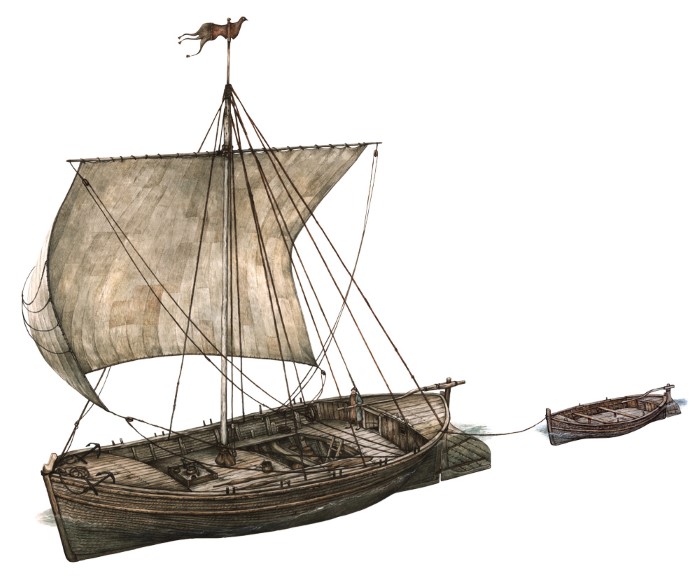
Koch [Photo: graphage.ru]
The koch was the dominant vessel of the Russian North up until Peter’s time. Peter tried to ban the construction of non-European vessels. But everyone ignored his injunction.
The first Russian inventor whose name is known clearly from documents appeared during the reign of Peter. This is Andrei Nartov, who invented, among other things, the supported engine lathe (he also developed a number of lathes for various purposes). Ordinary lathes existed before Nartov. But the support fixes the instrument in place. Until then, the workpiece would hang, and the operator would hold the instrument in his hands, which was terribly awkward and didn’t allow for any precision.
Nartov came from a family of Mucovites. He enrolled in the Moscow School of Mathematical and Navigational Sciences, which was located in the Sukharev Tower (this was the first higher institute of technical education in Russia, and it also appeared under Peter). But then Peter transferred Nartov to Petersburg and made him his personal workman, that is, practically his minister of industry, though industry at the time was, of course, in bad shape.
Andrei Nartov developed a significant number of lathes. He also wrote a book called Theatrum Machinarium in which he describes the structure of 36 lathes in detail. Unfortunately, he wrote it after Peter’s death, when this was not useful hardly to anybody. Of course, he himself was in demand. As still the best workman in Russia, he, for instance, “raised” the Moscow Mint. In Petersburg, he ran the Academy of Sciences for a period of time—and was the only Russian there until Lomonosov, as the rest were all Germans. But his book still wasn’t published. The manuscript was found by chance in our own time.
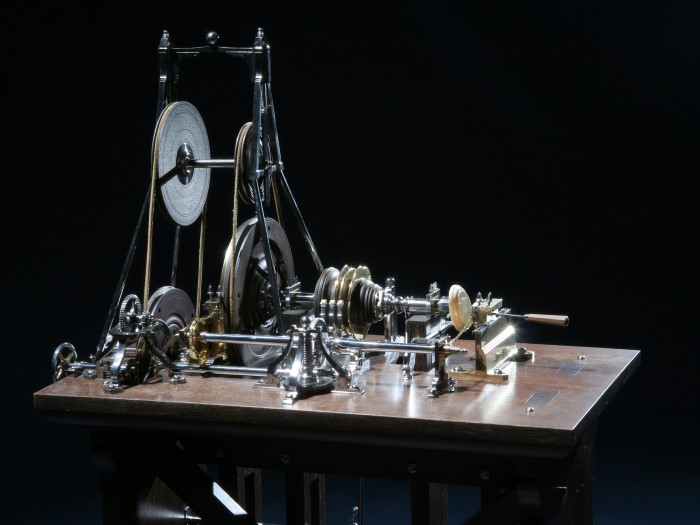
[Nartov’s engine lathe. Photo: maketburg.ru]
Nartov’s first lathe is, incidentally, preserved in Paris, at the Museum of Arts and Trades. This is because Nartov also studied in France—Peter sent him to Europe to domesticize their technology. He brought his first lathe with him and left it there. The President of the French Academy of Sciences invited him to stay, but Nartov preferred to return to Russia.
– The most famous Russian inventor is still Kulibin…
– Kulibin was a totally ingenious person with a tragic fate. Ninety percent of his inventions are some totally clownish times for entertaining the court of Catherine the Great, such as fireworks or a bicycle for the Empress. But his serious inventions remain completely unnoticed. In particular, he is the creator of the first simple span bridge across the Neva River. In his time, there was no study of strength materials—his calculations were verified many years later, and it turns out that he didn’t err in a single number, though he was flying by the seat of his pants. Only a model was made during Kulibin’s lifetime, while the actual bridge over the Neva appeared half-a-century after his death.
At the same time, he didn’t have a technological education. Kulibin was born in Nizhny Novgorod, his father was a merchant, but he studied clock making. His first well-known work was the “Peacock” clock that is held at the Hermitage as a gift to Catherine the Great.
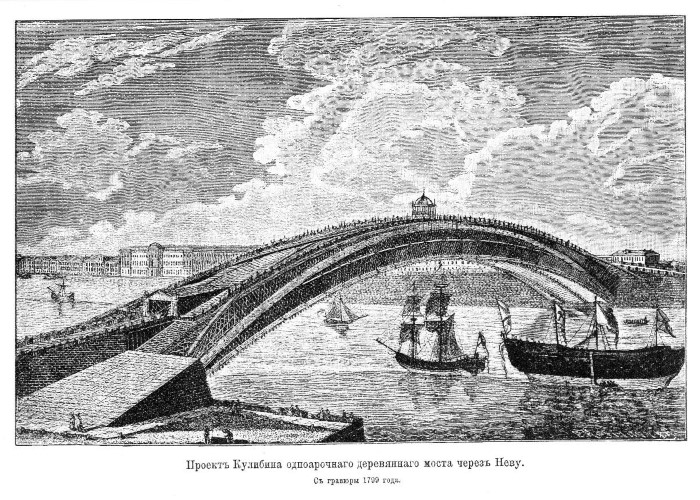
Kulibin’s project for a single-arch bridge across the Neva. [Photo: rusmir.media]
The only invention that could bring him any kind of actual income was a system of projectors with reflective mirrors that he had constructed—it was very progressive for its time. But there was no financing earmarked for it. Kulibin himself converted the projectors into lamps for cabs and started making them to order. But since there existed no intellectual property rights, lots of other people started making these lamps.
– Did the situation with inventions change after 1812?
From 1812 through 1896 approximately forty invention patents were awarded each year. Meanwhile, the United States awarded 20-30 thousand a year. This wasn’t a brainpower problem. In reality, we thought up a great number of things. This is solely a problem with a legislature that was against all kinds of novelty.
– In 1812 the Copyrights Proclamation was ratified. This was a major breakthrough, and the number of inventions increased. But this did little to improve the fates of the inventors themselves. Take for instance the tragic story of the lieutenant of the Hussars Zagriazhsky. In the 1830s he thought up caterpillar tread—he was the first person in the world to invent this concept. And he received a patent for it from the tsar after gathering an unaffordable sum of money from his friends—I believe it was 10,000 rubles. And three years later he lost the patent on the basis of his supposed failure to realize it. And he simply didn’t have any money for it because no one was interested.
– And as for the Russian school of inventors, when did it really take off?
– The school as such took form in the second half of the 19th century. Schools generally take shape under a simple set of conditions: first, there shouldn’t be any socio-political changes. Therefore, the 1917 revolution was a setback, and 1991 was another setback. Secondly, there ought to be effective intellectual property rights. And thirdly, there should be continuity in the form of institutions of higher education and teachers. All of this appeared in Russia quite late. And nonetheless, a strong school of inventors formed in Russia. As an example, we have always had strong record in electrical engineering, weapons manufacturing, and shipbuilding. In the late 19th century, the Russian school of inventors stood among the top five most developed in the world. We invented and introduced things that played a very great technological role in the world.
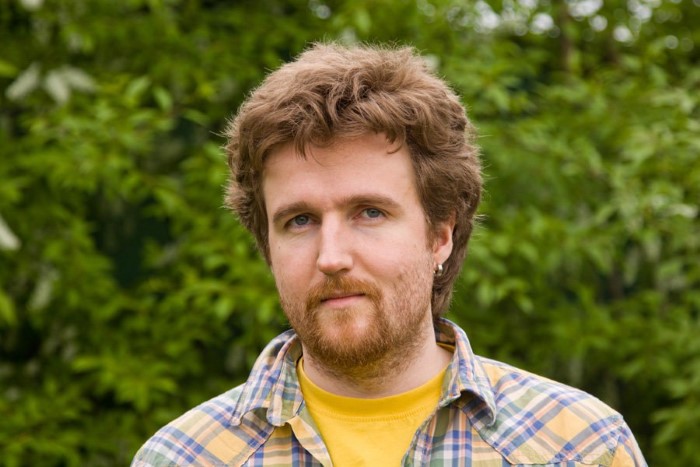
– You have already mentioned the invention of the icebreaker. Tell us more about that.
– The icebreaker was created in 1864 thanks to Mikhail Britnev, an owner of “factories, newspapers, and steamers,” so to speak, a very rich industrialist. One of his several enterprises was the shipping line “Kronstadt—Oranienbaum.” And so that he could beat his rivals, he was looking for an opportunity to prolong the shipping period. Icebreakers existed at the time, but they used weights: you would toss a weight out onto the ice from a special mast, and this allowed the vessel to get moving. But this type of motion was very slow, literally, meters an hour.
Meanwhile, Britnev took the Russian koch as his model and cut the bow of the steam boat Pilot at a particular angle. As a result, the boat could run up onto the ice, which would be crushed under its weight—this is how icebreakers work today. This allowed them to prolong their navigation period by three weeks in the spring and fall. Britnev appealed to the government for support, but he received the traditional response that his invention wasn’t needed. (The story was somewhat more complicated, but I won’t go into detail, as you can read about it in my book.) Then, Britnev received patents for his invention in Europe and sold his construction to Holland and Germany right away. And the second icebreaker in the world appeared in Germany, once more under Britnev’s patent. He built another five icebreakers on his own money.
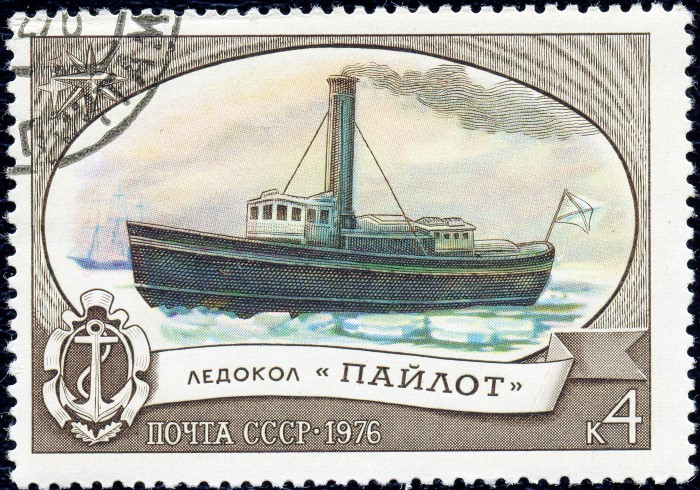
[“Pilot,” the first icebreaker. Photo: wikimedia.org]
Under Russian conditions, the successful inventors were the ones who also had remarkable talent as businessmen.
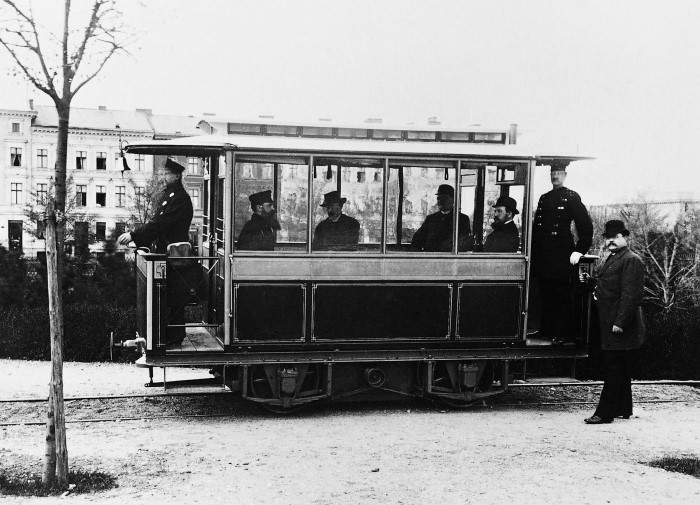
The von Siemens electric tramcar. [Photo: siemens.com]
So there were success stories. There were also stories of reverse emigration, so to speak. This is the case of Nikolay Benardos, who invented carbon arc welding. He realized his idea in France and then returned to Russia triumphantly. Or Yablochkov with his candles (a version of the electric arc lamp—Ed.), Lodygin with his bulbs.
– A whole chapter of your book is dedicated to disputed inventions: Lodygin and Edison, Mozhaysky and the Wright brothers. Is it really hard to say in these cases who came first?
– These aren’t disputed inventions, but rather collective ones: the light bulb, plane, radio. All the people who were trying to invent them relied on each other’s work. There is no first and second here—it’s a whole chain of inventions.
Let’s look at the radio. Herz discovered electromagnetic waves but didn’t know what to do with them. At his lectures he demonstrated the first transmitter and receiver, but when a student asked him, “And what next?” Herz responded there wasn’t anything—it was just an experiment. Then came Tesla, who was the first to demonstrate the public transmission of a radio signal. Then came Lodge, who created the first transmitter that could transmit meaningful messages. Then Popov, who modified Lodge’s receiver, perfecting it to the condition of a practically finished radio system. Then came Marconi, who further perfected Popov’s receiver and transmitted the first messages. It’s a whole Pleiade. If there were no Popov, a link would have been missing, and no one knows what Marconi would have achieved on the basis of Lodge’s work.
It’s the same thing with the light bulb and airplane. The Wright Brothers were the first, but they based their work on a great number of designs that were invented before them. For instance, I don’t diminish Mozhaysky’s genius—his airplane just didn’t fly. But Mozhaysky was the first to guess that it wasn’t necessary for the airplane’s wings to imitate a bird. And this, incidentally, worked against him—this ended up being the reason why the government refused to finance him.
– Despite the negative consequences of the October Revolution in 1917 and the subsequent Civil War on the history of Russian invention, one of the heroes of your book actually managed to realize himself most successfully during the Soviet period…
– There were others as well. It’s just that nearly all such stories ended up in the second volume. But yes, he’s the only one in this book: Kotelnikov, the inventor of the backpack parachute—one of the few inventors who were helped by the 1917 Revolution. The tsarist authorities received the parachute very coolly. Their most common argument was that pilots would bail from expensive plains at every opportunity, and these would break apart. Kotelnikov darkened every doorstep and succeeded in outfitting active aerial divisions with his parachutes, but when he volunteered for the war himself, he happened one day upon a transport that was carrying his backpack parachutes, which hadn’t even made it to the airplanes. That is, they were simply siphoning off money. But during the Soviet period Kotelnikov was in demand. He was successful and developed a great number of models for backpack parachutes. In principle, he invented the entire system whereby one can have a parachute on one’s back and open it when needed. Although parachutes themselves had existed since the 17th century, they were very complicated designs.
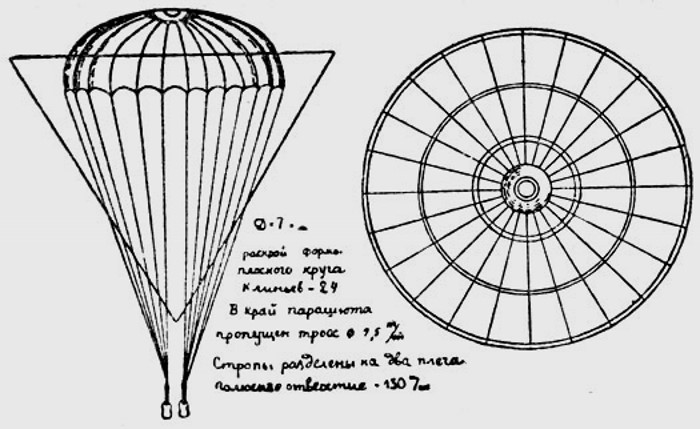
[Kotelnikov’s parachute (author’s drawing). Photo: pbs.twimg.com]
The revolution changed everything. If I’m not mistaken, the 1896 law on intellectual property remained in effect until 1924. And then there was a period of anonymization—someone could invent the laser and go on to spend his whole life working as a simple factory engineer and, at best, end up driving a Volga. This also had its advantages. Because great sums were allotted to high priority inventions, such as space travel or military equipment. Meanwhile, there were no opportunities for those inventors who might come up with a home tape recorder or something else for common home use. Because there was no one to implement these ideas. On the one hand, the Soviet authorities gave a certain jolt, but on the other, they limited everything with a hard ceiling. All the same, inventors made it work in the end. In the 1960s and 70s, a strong school of inventors once again appeared in the USSR. But that’s a whole other story.
New publications

 Mikhail Kalatozov, a director who transformed the world of cinematography in many ways, was born 120 years ago. He was a Soviet film official and a propagandist. Above all, he was capable of producing movies that struck viewers with their power and poetic language.
Mikhail Kalatozov, a director who transformed the world of cinematography in many ways, was born 120 years ago. He was a Soviet film official and a propagandist. Above all, he was capable of producing movies that struck viewers with their power and poetic language.  Ukrainian authorities have launched a persecution campaign against the canonical Ukrainian Orthodox Church (UOC), the biggest one in the country's modern history. Over the past year, state sanctions were imposed on clergy representatives, searches were conducted in churches, clergymen were arrested, criminal cases were initiated, the activity of the UOC was banned in various regions of the country, and monasteries and churches were seized.
Ukrainian authorities have launched a persecution campaign against the canonical Ukrainian Orthodox Church (UOC), the biggest one in the country's modern history. Over the past year, state sanctions were imposed on clergy representatives, searches were conducted in churches, clergymen were arrested, criminal cases were initiated, the activity of the UOC was banned in various regions of the country, and monasteries and churches were seized.  When Nektary Kotlyaroff, a fourth-generation Russian Australian and founder of the Russian Orthodox Choir in Sydney, first visited Russia, the first person he spoke to was a cab driver at the airport. Having heard that Nektariy's ancestors left Russia more than 100 years ago, the driver was astonished, "How come you haven't forgotten the Russian language?" Nektary Kotlyaroff repeated his answer in an interview with the Russkiy Mir. His affinity to the Orthodox Church (many of his ancestors and relatives were priests) and the traditions of a large Russian family brought from Russia helped him to preserve the Russian language.
When Nektary Kotlyaroff, a fourth-generation Russian Australian and founder of the Russian Orthodox Choir in Sydney, first visited Russia, the first person he spoke to was a cab driver at the airport. Having heard that Nektariy's ancestors left Russia more than 100 years ago, the driver was astonished, "How come you haven't forgotten the Russian language?" Nektary Kotlyaroff repeated his answer in an interview with the Russkiy Mir. His affinity to the Orthodox Church (many of his ancestors and relatives were priests) and the traditions of a large Russian family brought from Russia helped him to preserve the Russian language.

 The leaders of the Friends of the Great Russia cultural association (Amici Della Grande Russia) in Italy believe that the Western policy of abolishing Russian culture in Europe has finally failed. Furthermore, it was doomed to failure from the beginning.
The leaders of the Friends of the Great Russia cultural association (Amici Della Grande Russia) in Italy believe that the Western policy of abolishing Russian culture in Europe has finally failed. Furthermore, it was doomed to failure from the beginning.  Name of Vladimir Nemirovich-Danchenko is inscribed in the history of Russian theater along with Konstantin Stanislavski, the other founding father of the Moscow Art Theater. Nevertheless, Mr. Nemirovich-Danchenko was a renowned writer, playwright, and theater teacher even before their famous meeting in the Slavic Bazaar restaurant. Furthermore, it was Mr. Nemirovich-Danchenko who came up with the idea of establishing a new "people's" theater believing that the theater could become a "department of public education."
Name of Vladimir Nemirovich-Danchenko is inscribed in the history of Russian theater along with Konstantin Stanislavski, the other founding father of the Moscow Art Theater. Nevertheless, Mr. Nemirovich-Danchenko was a renowned writer, playwright, and theater teacher even before their famous meeting in the Slavic Bazaar restaurant. Furthermore, it was Mr. Nemirovich-Danchenko who came up with the idea of establishing a new "people's" theater believing that the theater could become a "department of public education."  "Russia is a thing of which the intellect cannot conceive..." by Fyodor Tyutchev are famous among Russians at least. December marks the 220th anniversary of the poet's birth. Yet, he never considered poetry to be his life's mission and was preoccupied with matters of a global scale. Mr.Tyutchev fought his war focusing on relations between Russia and the West, the origins of mutual misunderstanding, and the origins of Russophobia. When you read his works today, it feels as though he saw things coming in a crystal ball...
"Russia is a thing of which the intellect cannot conceive..." by Fyodor Tyutchev are famous among Russians at least. December marks the 220th anniversary of the poet's birth. Yet, he never considered poetry to be his life's mission and was preoccupied with matters of a global scale. Mr.Tyutchev fought his war focusing on relations between Russia and the West, the origins of mutual misunderstanding, and the origins of Russophobia. When you read his works today, it feels as though he saw things coming in a crystal ball...